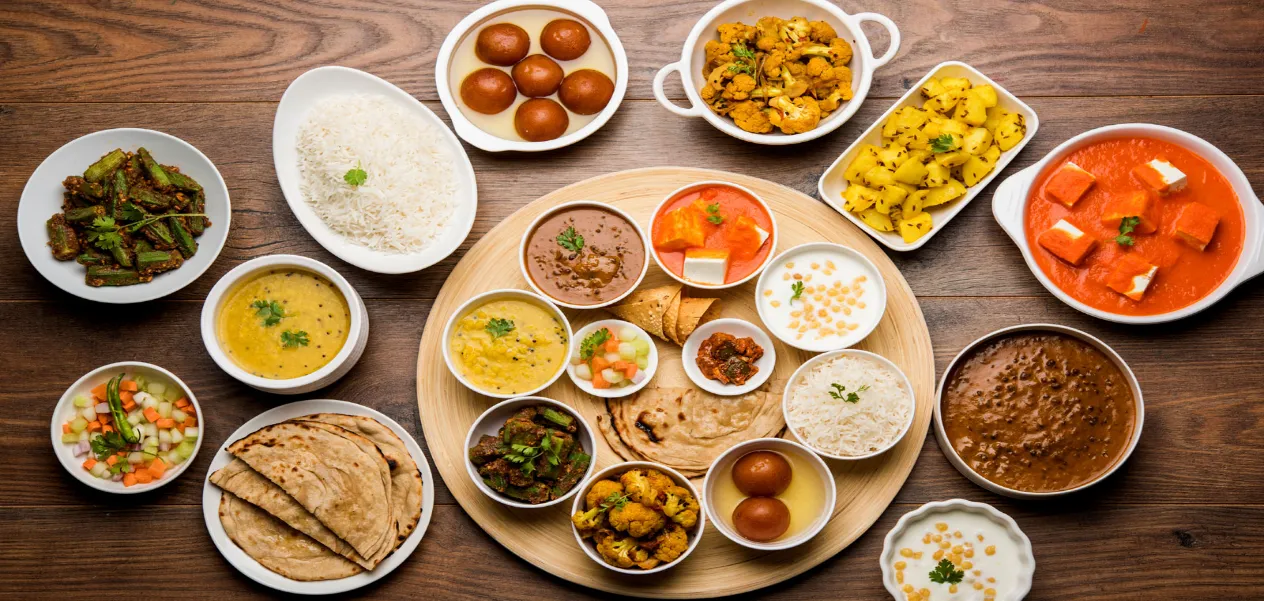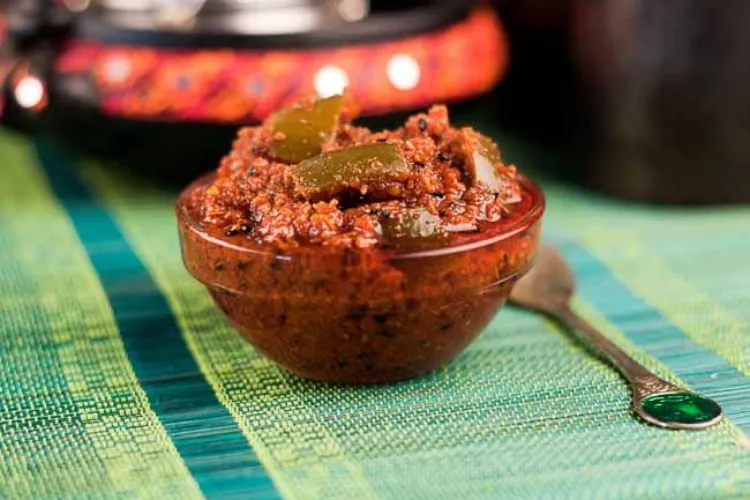
Puneetinder Kaur Sidhu / Chandigarh
_(1).webp)
The food of Punjab–simple, healthy, and linked to the land–reflects the history, culture and lifestyle of a region that boasts an agrarian legacy rooted in Harappan times. For, it was in the flood plains of the Indus, one of undivided Punjab’s five eponymous rivers that the Indus Valley Civilization (IVC) thrived.
It is believed to have been an urban society engaged in trade and farming, growing crops like wheat, barley, millets, chickpeas, and lentils, while buffalo milk, meat, fish, turmeric and ginger were dietary staples.
Even today, Punjab is the heartland of Indian agriculture and its fondness for all things dairy is legendary, as is its love for grain and seasonal vegetables. It is no surprise that the state’s most defining winter food pairing, saron da saag and makki di roti, eaten with dollops of freshly churned butter, is a mélange of all three.
.webp)
Makki ki Roti and Sarson ka Saag
Historically speaking, many an invader has successively stomped across the Khyber Pass since the tenth century, leaving a lasting imprint on the culinary heritage of the geography.
An active network of trade routes interlinked with the Silk Road led to a further influx of ingredients, plants, dishes and cooking techniques, including the simple, slow cooked tribal fare from the North Western Frontier Province. Peshawar gave Panjab the tradition of roasted fish and meats like the succulent mutton barra; the use of dried fruits and nuts is a bequest of Central Asia; potatoes, chilli peppers, and maize, among others, are thanks to the Colombian exchange.
A land thus enriched was partitioned to coincide with India’s independence from British rule in 1947, spurring an exodus of the displaced from a newly formed Pakistan. This would introduce a whole new culinary culture, as amongst the handful of possessions that fleeing families managed to bring along was the tandoor. These clay ovens would eventually help some of them rebuild their lives from scratch. Take the owners of Moti Mahal in Delhi’s Daryaganj, for instance, who are credited with giving us butter chicken, the now iconic restaurant dish!
Traditional Punjabi food, however, is characterized by freshness, purity, and straightforward methods of preparation. Certain homogeneity can be found in Panjabi households in terms of food habits, only cooking techniques or seasonings may vary. Wheat, millets, barley and maize remain the staple grains. Their flours are used to make a variety of breads–griddle-cooked rotis and parathas, deep fried pooris and bhaturas, and tandoor-baked kulchas and naans amongst them. Rice is an after-thought in the Panjabi diet but has managed to carve out a substantial niche for itself. Mostly preferred boiled or as a pulao, it couples with kadhi, rajma, aloo-wadi or curried chickpeas to become Punjabi cuisine’s most favoured food pairings. It is also consumed as mattar pulao, often eaten with a grated cucumber raita; and as Zarda, a sweetened rice version, particularly enjoyed during Basant Panchami. Another perennial dessert is the milky rice pudding kheer, which transforms into roh di kheer during winter months when milk is replaced with sugarcane juice.
.webp)
Amritsari Aloo Kulcha
Seasonal vegetables are an important staple, with vast tracts of Punjab’s plains devoted to their cultivation. A host of vegetables, among them aloo-gobhi, gajjar-mattar, baingan bhartha, crispy fried bhindi, stuffed karela, is what gives a Panjabi meal its crunch and colour. A sweet and sour pickle made with carrots, cauliflower and turnips is a constant in winters, as is gajrela or gajar pak. Dal is equally essential, and is usually tempered with garlic, onions or cumin in aromatic desi ghee. It must be clarified here that Punjabi cuisine is not excessively dependent on ghee, butter and cream as usually perceived. The thick creamy texture of the famed mah di dal or dal makhani, for instance, does not result from a generous infusion of fat. Rather, it is acquired by slow cooking the dish over several hours, oftentimes overnight.
.webp)
Baingan ka Bharta
What accounts for Punjab’s healthy consumption of milk, ghee, butter, curds, and buttermilk is that the people here are by and large blessed with low levels of lactose intolerance. Hence paneer, the star ingredient in many a vegetarian dish, finds its way into meals with unfailing regularity! It is eaten crumbled into a bhurji, cubed into a curry with green peas, folded into mashed spinach, or used as barbecued tikkas to snack on. It also shows up as chenna along with khoya in many a sweet.
Contrary to popular belief about their carnivorous ways, over fifty percent of Punjabis are vegetarians. Those that eat meat, prefer chicken, goat, and lamb in varied forms, which is how tandoori chicken, chicken tikka, mutton curry, mutton burra, and keema-mattar took centre-stage. Fresh water fish is another important staple. Some of the finest singhara and sole catches come from Harike Pattan, the place where the rivers Beas and Sutlej merge. This close proximity to Amritsar is how the tandoori, and ajwain-infused batter-fried forms, became synonymous with the holy city.
Condiments like home-made pickles, chutneys, and murabbas are must-haves on a Punjabi table, forming nutritious and flavourful complements to a meal. They require little cooking and are mainly made with vinegar, brine and mustard oil. Pickled lime, mango, and sundry winter vegetables are universal, while chutneys and relishes can be region-specific. Majha likes them fresh and green, Doaba prefers them sweet and sour and made of mangoes, while Malwa embraces the whole gamut from coriander and mint to smashed chibbad (cocomelons). Murabbas have definite medicinal properties, are revitalizing, and often step in as a substitute for dessert.

Punjabi Mango Pickle
It is no secret that Punjab also has a massive sweet tooth. Gur and shakkar are permanent fixtures in the kitchen, and more often than not mark the end of a meal. Special occasions call for kheer or seviyan, while winter brings the nutrient-rich panjeeri and gajar halwa in its wake. Other mithais include ladoos, barfi, gulab jamun, jalebis, and pinnis made from ghee, wheat flour, jaggery and almonds. Punjabis also love their snacks. Crispy home-made flour and suji mathis, both sweet and savoury, are a comfort food and when paired with mango pickle a popular tea-time treat. Other favourites include the deep fried samosas, kachodis, assorted vegetable and paneer pakodas.
.webp)
Gajar ka Halwa
Punjab’s hot summer months beg refreshing beverages, of which sweet lassi, salty buttermilk, jal jeera, shikanji, and fresh fruit juices are commonly consumed. Old-timers swear by Sattu,a protein-rich and refreshing drink made from roasted and powdered barley or kala channas, best suited for the region’s sweltering heat. Kanji, a fermented drink prepared with kaali gajjar is a long-awaited winter special, as is sugarcane juice flavoured with a bit of ginger and lime juice. The most preferred beverage, however, remains tea. Drunk hot and sweet with milk, often flavoured with cardamom, it counts as the one lasting influence of a century’s worth of colonial rule.
Food-loving Punjabis, with their unmatched zeal for living the good life, are perhaps the best personification as a community of what joie de vivre really means. ‘Khaada peeta lahe da, baqi Ahmed Shahe da’ (What we eat and drink is ours; the rest is Ahmad Shah’s). This oft-quoted maxim may be of recent vintage, coined in the 18th century when the Afghan marauder, Ahmad Shah Abdali, made his pillaging visits, but it not only informs Punjab’s constant quest for la dolce vita, it also explains its proclivity to live in the moment.
(Puneetinder Kaur Sidhu is a Chandigarh based food critic, travel writer and columnist. She is the author of 'Punjab - A Culinary Delight.')
